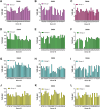Diversity of human salivary heparan sulfate
- PMID: 39361890
- PMCID: PMC12098930
- DOI: 10.1093/glycob/cwae084
Diversity of human salivary heparan sulfate
Abstract
The human oral cavity and upper airway serves as an early barrier and reservoir in the transmission of SARS-CoV-2. Saliva in this microenvironment may serve as a key host factor that can modulate susceptibility to infection and eventual infection of the lower respiratory tract. We sought to analyze the content and composition of heparan sulfate, a glycosaminoglycan identified as an important co-receptor for viral entry, and whether there is any correlation with SARS-CoV-2 infection. We enlisted 98 participants stratified by age, gender, race, and COVID-19 history. Notably, the concentration of heparan sulfate in saliva increased with age, and its composition showed a wide range of variability within each age group independently of age. Heparan sulfate concentration and composition did not differ significantly with gender, ethnicity or race. Compared to patients with no COVID-19 history, patients with previous infection had a similar salivary heparan sulfate concentration, but significant increases in overall sulfation were noted. Moreover, in a subset of participants, for which data was available pre- and post- infection, significant elevation in N-sulfoglucosamine in heparan sulfate was observed post- COVID-19. Examination of salivary bacterial 16S rRNA, showed a significant reduction in species predicted to possess heparan sulfate-modifying capacity among participants >60 years old, which correlates with the increase in heparan sulfate content in older individuals. These findings demonstrate a surprisingly wide variation in heparan sulfate content and composition in saliva across the sampled population and confirm other findings showing variation in content and composition of glycosaminoglycans in blood and urine.
Keywords: Covid-19; age; heparan sulfate; microbiome; saliva.
© The Author(s) 2024. Published by Oxford University Press. All rights reserved. For permissions, please e-mail: journals.permissions@oup.com.
Figures





References
MeSH terms
Substances
Grants and funding
LinkOut - more resources
Full Text Sources
Medical
Miscellaneous

